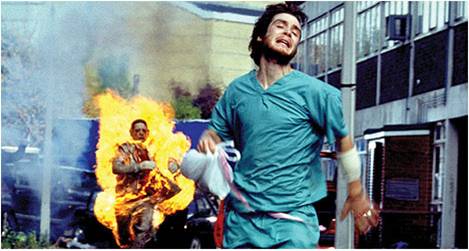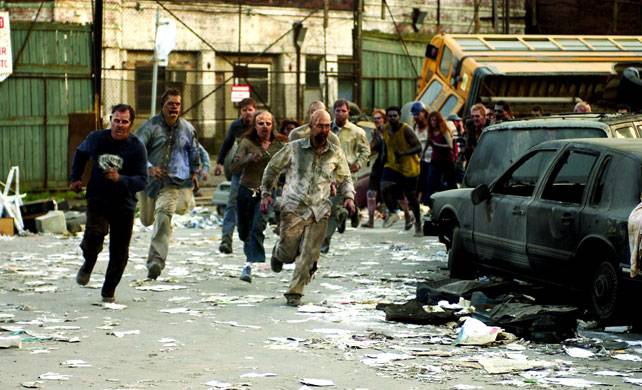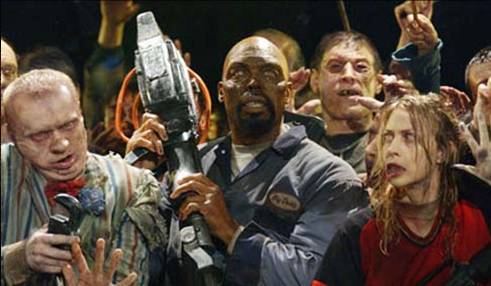Below is Part 3 of a three part essay (Part 1 is available here; Part 2 is available here) I will be presenting at the 2012 Southwest Texas Popular Culture Association meetings in Albuquerque, New Mexico on February 9th. I will be presenting alongside several other scholars for a series of panels titled “The Apocalypse in Popular Culture.” A (much) earlier version of this paper can be found on the Sociological Images sister blog. Part 3 discusses the “Zombie Renaissance” after 9/11 and concludes briefly on the importance of the zombie as a cultural artefact.

Scholars have called the post-9/11 era the “Zombie Renaissance” due to the torrent of zombie films produced at this time and the paradigmatic changes introduced to the zombie as movie monster (Bishop 2010). The first blockbuster film of this era, Danny Boyle’s 28 Days Later (2002) is often credited to raising the stakes in zombie films. This film became a powerful drama oriented around the zombie apocalypse, something that has since been mimicked in recent films and especially in AMC’s recent television series The Walking Dead.
Perhaps most importantly, Boyle’s film is also credited in the creation of a new breed of zombie, the fast-moving, disease-infected living type I outlined at the onset of this presentation. These zombies are no longer depressed automatons, but enraged, feral, and overcome with madness. They sprint rather than shuffle; and more than brains they seek to spread the infection further, spewing blood and bile onto their victims in addition to devouring them.
28 Days Later also set the stage for a dramatic expansion of the zombie narrative, both in terms of special effects and in scope. In the film, the entire world is said to have succumbed to the “rage virus” and the protagonists must struggle to survive without the safety of social institutions. In fact, the very social institutions established to protect humanity become threats to survival, as the protagonists find out when they bunker down with renegade soldiers who attempt to rape and kill them.
The themes of social decay portrayed so eloquently in 28 Days Later have since become a staple of the zombie genre. This is made most salient in films that draw direct parallels to global terrorism and social unrest. Zombie films like Dawn of the Dead (the 2004 remake of the Romero classic) take this to a new level, portraying dystopian anarchy on a grand scale that could not be achieved in early renditions of the zombie apocalypse. With characters left to fend for themselves, these “everyman” tales become gripping stories of individualism and resilience, thereby resonating with Western audiences.
But the social criticism of earlier zombie films was not lost in these recent films. Romero, particularly, has been keen to maintain explicit social commentary in his recent films. His more recent, Land of the Dead (2005) has often been credited as an indictment of the Bush era corporate-political inbreeding, in which the rich close themselves off in the opulent Fiddler’s Green while the masses wallow in filth on the streets below, forever at risk of zombie invasion. In addition, the very structures enacted to protect us actually become our own undoing, as the barricades constructed to keep out the zombie horde ultimately serve to prevent the characters’ escape.

In recent years we have also seen a resurgence of the zombie as a comedic element. Films like Shaun of the Dead (2004) and Dance of the Dead (2008) portray scathing social commentary while using the zombie survival narrative as comedic relief. Similarly, the film Fido (2006) portrays historical revisionism in its portrayal of 1950s America, in which racial tensions are replaced with tensions between domesticated zombie slaves and their human masters.

In my opinion, zombie serves as a fluid and powerful metaphor for articulating our deepest cultural anxieties and social fears. Borrowing Axel Bruns (2007) concept of the “artefact,” an incomplete product that has neither an absolute beginning nor end, we can articulate the zombie as a collectively-produced cultural artefact. Its life cycle continues to grow and change with each successive film, spawning new creatures, deviations, and forking into new domains. In this sense, the zombie is a resilient metaphor that allows various ideas to be grafted upon it. As Peter Dendle (2008) has so eloquently argued, the zombie thereby serves as a “barometer” of our collective anxieties at different points in history.
In addition, the zombie apocalypse and the survival narrative of many of these films provides a magnificent medium from which to make political and social statements, a vantage point from which contemporary (non-zombie) society can be dichotomized. The stories of survival contained in these films always contains implicit a criticism of the prevailing social order and the dystopian future that awaits us.

Finally, the zombie has acquired a powerful cultural currency since 9/11. It has spawned powerful new narratives of society and the individual, and invigorated gun enthusiasts and doomsdayers with models for survival (Dendle 2008). It has led to a distinct subculture of horror fans that identify with the zombie, inspiring “zombie walks” across the country and spurring fan communities across the globe. Given that the collective consciousness continues to identify so strongly with the zombie narrative, we will probably only see more zombie related media and activities emerging in the near future. In fact, we already have college courses and anthologies dedicated to the zombie. In this sense, the zombie will live on as part of our cultural understanding of mass society, offering us an image of the future but also a critique of the present state of the social order.
Selected References:
Bishop, E. 2010. American Zombie Gothic: The Rise and Fall (and Rise) of the Walking Dead in Popular Culture. Jefferson, NC: McFarland.
Dendle, P. 2007. “The Zombie as Barometer of Cultural Anxiety.” In N. Scott (Ed.), Monsters and the Monstrous: Myths and Metaphors of Enduring Evil. New York: Rodopi. Pp. 33-43.
Pagano, D. 2008. “The Space of Apocalypse in Zombie Cinema.” In S. McIntosh and M. Leverette (Ed.), Zombie Culture: Autopsies of the Living Dead. Lanham, MD: Scarecrow Press. Pp.71-86.



Comments 1
The Zombie in Film (Part 3: The Zombie Renaissance) » Cyborgology | Zombie Mania | Scoop.it — February 20, 2012
[...] background-position: 50% 0px; background-color:#222222; background-repeat : no-repeat; } thesocietypages.org - Today, 9:25 [...]